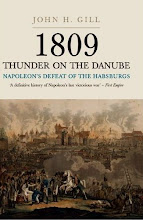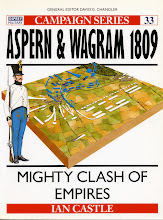 Whitecoats, at last! Part of IR35 (Argenteau)
Whitecoats, at last! Part of IR35 (Argenteau)
"Where the hell has HE been?", I can hear people asking.
Well, to put it mildly my first foray into the world of 6mm was very disappointing. I just wasn't happy with the results I was getting, and was finding that the visual switch to 6mm after years of 25/28 miniatures was -literally- giving me headaches.
After going through a number of false starts and trying a number of different painting techniques, I found myself failing a succession of morale throws resulting in a total rout. I pretty much gave up in frustrated despair, all the time myself shaking my head over how Braxen was able to get such wonderful results on his minis without having to wear glasses the thickness of Pepsi bottles. I actually came close to ditching the whole lot (well, sending them to Braxen at any rate).
For a while after that I did not do much painting at all, as work was taking a heavier toll of my time, but eventually I did get back- to my 28's. I have been making good progress in that area, and the last couple of months saw me at work on French infantry and chasseurs a cheval. I had put 6mm in the back of my mind, and for a long time I didn't look at this blog out of embarrassment at having to publicly admit defeat, and even contemplated getting myself a chamberpot with Pete Berry's picture inside it...
However...
This past Friday I was in the middle of painting a grey (almost white) horse for a mounted French "bigwig", and was feeling pleased with myself about how it was turning out. I then found myself wondering whether the same technique would actually work with my 6mm Austrians.
So on a whim (and as a break from the 28's) I took out a few bases worth of Kaiserliks and started painting. To my surprise, I found myself actually beginning to enjoy it as I saw that I was getting a finished product that I was happy with.
It helped that a month ago a got myself both new reading glasses (I suffer from considerable short-sightedness), and a light bulb for painting that gives off "natural" light. Not as bright as a standard light bulb, but what you see while painting is what you get once the painting session is done and the figures are on the table. It helps to eliminates that "garish" look that sometimes result from having painted in too strong a light.
The figures had already been undercoated in white, so I gave them a basecoat of Ceramcoat's soft grey, followed by a wash of quaker grey and a "wettish" drybrushing of pure white. This gave me what I was looking for- shading which was not too strong visually, but which was subtle enough so that the uniforms were clearly white- without being too stark.
I was able to learn a number of things in the process about painting 6mm- with white uniforms, avoid extremes of colours by using charcoal rather than black for helmets and cartridge boxes, and just suggest the facing colours with a dab here and there.
So above here is the picture of a "test stand" that I completed as a model for the rest of the regiment IR.36 (Argentau's). Although not the greatest close-up shot, I'm quite pleased with the figures. 6mm is not really at its best at this distance anyway- it is best seen en masse and at arm's length viewing at least.
The rest of the regiment is already 40% complete. I'll see if I can get it done over the weekend in between working on my 28's. Psychologically, I find this works well for me as the variety helps keep up momentum.
I'd love to start working on terrain boards for these guys, but first things first; paint infantry. I do not want to bite off more than I can chew.
Robert




 Mass effect is starting to show. I will need of course to texture and flock the bases.
Mass effect is starting to show. I will need of course to texture and flock the bases.




